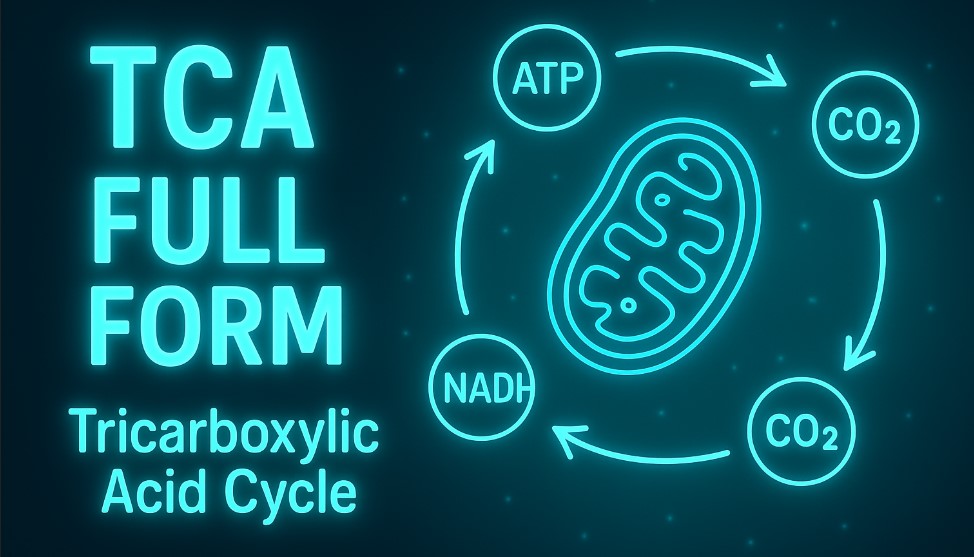Table of Contents
TCA Full Form: The Tricarboxylic Acid Cycle, or TCA cycle, is a vital process for life. You might also know it as the Krebs cycle or the citric acid cycle. Think of it as the central engine inside our cells that burns fuel for energy. This is the second of three main stages in cellular respiration, the way living things get energy from food.
Almost every living thing—from the smallest bacteria to plants, animals, and you—uses this process. In most organisms, it happens inside a part of the cell called the mitochondria, often nicknamed the “powerhouse of the cell.”

What is the TCA Cycle?
TCA is short for Tricarboxylic Acid. The TCA cycle is a series of chemical reactions that helps our cells release stored energy. It breaks down a molecule called acetyl CoA, which comes from the carbohydrates, fats, and proteins we eat. The main goal is to create high-energy molecules that will later be used to make ATP, the cell’s main energy currency.
The cycle is called a “cycle” because the molecule that starts the process is remade at the very end, ready to start all over again. It’s a closed loop that keeps running as long as it has fuel and oxygen.
TCA Cycle Overview
| Step | What Happens | Enzyme | Energy Made |
| 1 | Acetyl CoA + Oxaloacetate → Citrate | Citrate synthase | — |
| 2 | Citrate → Isocitrate | Aconitase | — |
| 3 | Isocitrate → α-Ketoglutarate | Isocitrate dehydrogenase | 1 NADH |
| 4 | α-Ketoglutarate → Succinyl CoA | α-Ketoglutarate dehydrogenase | 1 NADH |
| 5 | Succinyl CoA → Succinate | Succinyl-CoA synthetase | 1 GTP (ATP) |
| 6 | Succinate → Fumarate | Succinate dehydrogenase | 1 FADH2 |
| 7 | Fumarate → Malate | Malate dehydrogenase | — |
| 8 | Malate → Oxaloacetate | Fumarase | 1 NADH |
Do Check – IBM Full Form
Why is it Called the Krebs Cycle?
The TCA cycle gets its other famous name from Sir Hans Adolf Krebs. He was a British scientist who figured out most of the steps in this pathway back in the 1930s. He won a Nobel Prize for his amazing work. Later, other scientists helped complete the picture, but the name “Krebs cycle” stuck.
Must Check – List of All Full Form
How the TCA Cycle Works: A Step-by-Step Guide
Big food molecules like sugars and fats can’t just jump into the cycle. First, they are broken down into the two-carbon molecule, acetyl CoA. This is the entry ticket for the cycle. Once acetyl CoA enters, it goes through eight key steps. Each step is helped along by a special protein called an enzyme.
The 8 Steps of the TCA Cycle
- Step 1: The Cycle Begins. Acetyl CoA joins with a four-carbon molecule called oxaloacetate. They combine to make a six-carbon molecule called citrate. This is why the cycle is also called the citric acid cycle!
- Step 2: A Quick Rearrangement. The citrate molecule is changed slightly to become isocitrate.
- Step 3: First Energy Capture. Isocitrate is oxidized. It releases a molecule of carbon dioxide (CO2) and creates the first energy-carrying molecule, NADH. A five-carbon molecule called α-ketoglutarate is left.
- Step 4: Second Energy Capture. The α-ketoglutarate is oxidized too. It also releases a CO2 molecule and creates another NADH. This leaves a four-carbon molecule called succinyl CoA.
- Step 5: Making ATP/GTP. The succinyl CoA is changed into succinate. This step releases enough energy to make one molecule of GTP (or ATP in some cells). This is a small but direct energy boost.
- Step 6: Third Energy Capture. Succinate is oxidized to form fumarate. This time, the energy is captured by a different molecule called FAD, which becomes FADH.
- Step 7: Adding Water. A water molecule is added to fumarate, turning it into another four-carbon molecule called malate.
- Step 8: Getting Back to the Start. Finally, malate is oxidized to recreate oxaloacetate—the molecule from Step 1! This process also creates one last NADH molecule. Now the cycle is ready for the next acetyl CoA.
Do Check: AICTE Full Form
What Does the TCA Cycle Make?
For each single turn of the cycle (using one acetyl CoA), the final products are:
- Two molecules of carbon dioxide (CO2)
- Three molecules of NADH
- One FADH molecule
- One molecule of ATP (or GTP)
Remember, one glucose molecule from your food creates two acetyl CoA molecules. So, for every one molecule of glucose, the TCA cycle runs twice, and you can double all these products!
Do Check: USB Full Form
Conclusion: The Central Hub of Energy
The TCA cycle is much more than just a list of chemical reactions. It’s the central hub of metabolism, connecting the breakdown of all major food groups to the production of energy. While it doesn’t make a lot of ATP directly, its main job is to create the NADH and FADH2 molecules. These are like energy-rich shuttle buses that drop off their energy to the next and final stage of respiration, the electron transport chain, where the vast majority of a cell’s ATP is made. Understanding the TCA (Tricarboxylic Acid) cycle is key to understanding how our bodies work, how we get energy from food, and how all life is connected through these basic chemical processes.
TCA Cycle Full Form FAQs
Why is it called the TCA cycle?
It is called the TCA cycle because the full name is Tricarboxylic Acid Cycle. This name comes from the type of acids involved in the process, which have three carboxyl groups. The first product made in the cycle is citric acid, which is a tricarboxylic acid, so the whole pathway got named after that. Sometimes people call it the citric acid cycle or the Krebs cycle, but “TCA cycle” is the scientific name.
What is the function of TCA?
The main function of the TCA cycle is to create energy for the cell by breaking down small molecules that come from our food. It changes acetyl CoA into important energy carriers like NADH and FADH2, which later help make ATP, the cell’s energy money. Besides making energy, the TCA cycle also makes smaller building blocks for other important things in the cell, like some amino acids and fats. It is one of the most useful cycles inside cells for getting energy and building stuff.
Who discovered the TCA cycle?
The TCA cycle was discovered by Sir Hans Adolf Krebs in the 1930s. He was a British scientist who figured out nearly all the steps and showed how it worked in cells. He received the Nobel Prize for his discovery, and many students now learn about the Krebs cycle in his honor. But it was also finished later by more scientists who helped figure out some smaller details that Krebs missed.
What is an example of a tricarboxylic acid?
Citric acid is a good example of a tricarboxylic acid. It’s found naturally in lemons and other citrus fruits, and it is also the first molecule created at the start of the TCA cycle. Tricarboxylic acids always have three carboxyl (COOH) groups in their chemical structure—citric acid is the most famous one for students learning this cycle.
Where is the TCA cycle located?
The TCA cycle happens inside a part of the cell called the mitochondria. Mitochondria are often called the powerhouses of the cell because they make most of the cell’s energy. In bacteria, though, the TCA cycle does not happens in mitochondria, it happens in the cell’s fluid instead because bacteria don’t have mitochondrias. For all others, this vital cycle happens deep inside cells, within mitochondria, where enzymes help speed up the steps and make energy from the food we eat.









